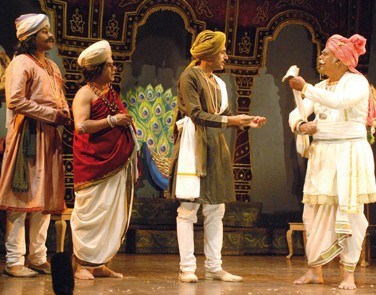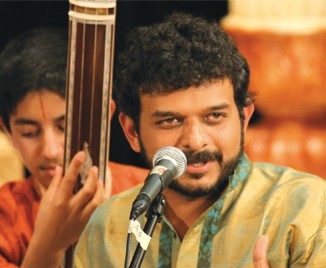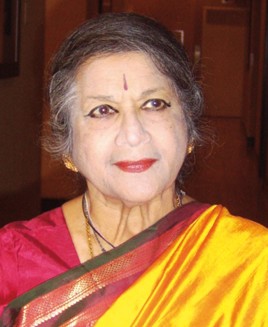NEWS & NOTES - Desh Parva – Celebrating India by K.K. GOPALAKRISHNAN

Desh Parva, a festival of dance, music and theatre organised in October at Delhi by the Sangeet Natak Akademi, displayed the multicultural forms of India – both classical and folk – enhancing the festive atmosphere of Delhi as part of the Commonwealth Games.
The daily programme Kul Varnika featured some significant writings from the Common-wealth in performance. “The word and the art find their inspiration in each other. Kul Varnika explores word and art, one through the other. In this Abhinaya takes us forward. Abhinaya is expression in presentation, and leads us to Rasa, the essence that has the power to move us and transform us. Then each performance becomes a truly personal experience,” says the Akademi in its introductory note on this laudable attempt.
Maya Krishna Rao, Geeta Chandran, Hema Singh, Tripura Kasyap, Shagun Butani and Navtej Singh Johar (Delhi) Priti Patel (Kolkata), Anita Ratnam and Preeti Athreya (from Chennai) and Ashish Vidyarthi (Mumbai) were the performers of Kul Varnika interpretating the writings they chose. While some of the presenta-tions were narrative and within the structure of predefined formats, others were highly abstract leaving it to the imagination of the audience. For instance, Ashish Vidyarthi, in his theatrical interpretation of Derek Walcott’s A City’s Death by Fire approached it with a three-dimensional angle incorporating the points of view of his own city razed by fire, of the audience as well as his own.
COVER STORY - T.M. KRISHNA - The voice within by V Ramnarayan

A few months ago, Sruti received inside information that T.M. Krishna was not going to perform during December 2010. It seemed a logical next step to feature him in the December issue, and we caught up with him in October-November for extensive personal interviews. The next issue of Sruti will carry more comment on Krishna, and interviews with him as well as his friends, disciples, mentors, peers, and critics.
Krishna emerges as an unusually consistent person who shows the same face to all concerned, regardless of their age, gender, social status or artistic accomplishments. The Krishna his accompanists and peers know is the same Krishna known to elders, mentors, friends and admirers. He has his share of critics and he admits he can easily be misunderstood, but expresses his willingness to engage in conversation with both his critics and his followers who may be disturbed by some of his unusual acts and statements. We present his profile in two parts: a general write-up on him plus perspectives by wife, guru, mother and senior in this issue and excerpts from his freewheeling interview with this author as well as appraisals by a whole host of others as told to Gayathri Sundaresan, in the January 2011 issue.
It is a magical night under a starless sky at Kalakshetra’s newest offering to arts lovers: the Padma Pushkarini – named after the late, much-loved Padmasani Teacher, who was responsible for the greening of that august institution when it moved from Adyar to Tiruvanmiyur in the 1960s. An eager audience of young and old listens in hushed silence to the mellow, soul-searching kind of music that the environs of Kalakshetra always seem to inspire. Tonight’s experience is special even by Kalakshetra standards, whatever inspired Leela Samson and her team to create this beautiful performance space reminiscent, according to violinist R.K. Shriramkumar, of the venue at Maheshwar on the banks of the Narmada, where he and Krishna performed a couple of years ago.
Vocalist T.M. Krishna appears so moved by the beauty and grandeur of the music that he stops more than once, apparently unable to give voice to his surging emotions in what seems to be a cathartic experience for singer and listener alike, with wet eyes and bowed heads merging into the gentle nightscape of oil lamps and quietude. His Kaalai tookki ninradum deivame in Yadukulakambhoji and Bhairavi swarajati Kamakshi are extraordinary explorations, Krishna’s resonant voice, now tender and beseeching, again soaring in controlled expansiveness, entering their every nook and cranny and leaving his devout offerings before their altar, as it were.
HERITAGE - The Season, 75 years ago by SRIRAM V

The 1935 Season was a low-key affair. Those in charge perhaps had other things on their minds. Most notably, the Government of India Act was passed that year promising greater autonomy to the provinces, an end to dyarchy and finally, the vague provision for the establishment of a Federation of India, involving the Raj-controlled provinces and the princely states. The last was to keep several lawyers of Madras too busy to wholly participate in the Season.
Unlike earlier years, three organisers hosted concerts in 1935. In addition to the usual players – the Music Academy and the Indian Fine Arts Society, the Congress Party which turned 50 that year, held music programmes under the auspices of the Khadi and Swadeshi Exhibition, an annual feature since 1934. With concertgoers spoilt for choice, the organisers feared a poor audience turnout at each of the venues.
The Indian Fine Arts Society was going strong, with funding from the Arya Vaisya Chettys of Madras enabling it to conduct its programmes with a degree of grandeur that the Academy could not manage. The Academy however stole a march with its faultless planning. A new committee was in charge there, led by a new President K.V. Krishnaswami Iyer. He took over from Dr. U. Rama Rau, and was something of a martinet, who demanded clockwork precision in the conduct of the conference.
NEWS & NOTES - Kamala receives US National Award by UMA DANDAPANI (A New York-based freelance journalist)

In the emergence of Bharata-natyam as a classical Indian dance style with global appeal and recognition, Kamala Narayanan’s has been a major role. Over the past seven decades, her proven calibre as an artist has only enhanced her mystique. The Padma Bhushan recipient was recently conferred a new distinction. On 22nd September 2010, she became the first Bharatanatyam artist in the United States to receive the prestigious National Heritage Fellowship, the country’s highest honour in the Traditional and Folk Arts, in a ceremony hosted by the National Endowment for the Arts at the Library of Congress. She was among a select group of nine master artists from different fields to receive a plaque with a citation engraved in marble, from NEA Chairman, Rocco Landesman. The other artists honoured included American folklorist Judith McCulloh, Ghanaian drumming artist Yacub Addy, bluegrass guitarist and singer Del McCoury, Irish flautist Mike Rafferty and Afro-Cuban drummer and drum-maker Ezequiel Torres.
The venue was Room 119 – a conference hall with an unpretentious name and elegant décor. Kamala sat beside her fellow honourees, with a gold pin, gifted by the NEA to each of the Fellows, fastened on her blouse.


